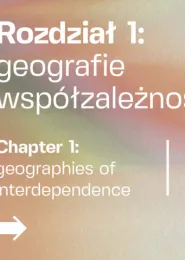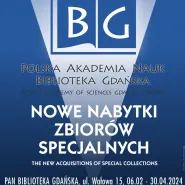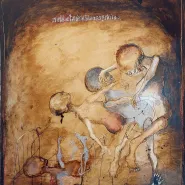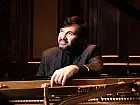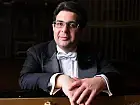Rozdział 1: geografie współzależności to międzynarodowa wystawa zbiorowa, która podejmuje temat wzajemnych powiązań pomiędzy ludźmi a istotami nieludzkimi.
Podobne wydarzenia
6 lutego - 30 kwietnia 2024
Gdańsk,
Biblioteka Gdańska PAN
Wstęp wolny
25 października - 8 listopada 2024, godz. 19.00
Gdańsk,
Galeria Triada
Wstęp wolny
Artyści: Martyna Czech, Kapwani Kiwanga, Uriel Orlow
Poprzez prace zaproszonych artystów publiczność przyjrzy się zależnościom pomiędzy zwierzętami, roślinami i zjawiskami, które pełniąc różne funkcje w kontekście historycznym i społecznym, nabierają nowych znaczeń i przenoszą ważne kulturowo treści. W jakim stopniu rośliny i zwierzęta mogą być symbolem zmian społecznych? Jak włączyć aktorów nieludzkich do dyskusji w sferze społecznej i kulturalnej? Czym jest współzależność w kontekście najbliższego otoczenia i szerzej, w globalnych trendach? Do udziału w wystawie została zaproszona trójka artystów, których prace tworzą narracje na temat złożoności tych relacji w międzynarodowym kontekście.
Malarstwo Martyny Czech komentuje relacje pomiędzy ludźmi a zwierzętami; praca wideo Uriela Orlowa to historia Artemisi (bylicy rocznej), pokazana za pomocą obrazu i dźwięku. Kapwani Kiwanga w swojej instalacji analizuje symboliczny związek kwiatów z jednostkami, narodami i ruchami oporu.
Wystawa jest pierwszym rozdziałem, wstępem, do serii projektów opartych na researchu wokół narzędzi konceptualnych, takich jak idee współzależności, dzielenia się czy szeroko rozumiana opieka.
Rozdział 1: geografie współzależności są częścią rocznego programu sztuk wizualnych, który w 2023 roku jest poświęcony cyrkulacjom działania.
Kuratorka: Kasia Sobczak
Wernisaż: 19.05, godz. 19.00
Wystawa: 20.05 - 17.06.2023
Program publiczny towarzyszący wystawie:
20.05, godz. 11.00 spotkanie z Martyną Czech i Kasią Sobczak, oprowadzanie po wystawie
27.05, godz. 11-19.00 warsztaty W poszukiwaniu aktorów nieludzkich, prowadzenie: Sylwia Bruna, Aleksandra Kulińska, Bartosz Rief*
30.05, godz. 15.00 oprowadzanie dla licealistów
10.06, godz. 11.00 oprowadzanie kuratorskie
Godziny otwarcia wystawy:
Wtorek- piątek, godz. 14.00 18.00
Sobota, godz. 10.00-14.00
Biogramy artystów:
Martyna Czech (1990), absolwentka malarstwa na Akademii Sztuk Pięknych w Katowicach w pracowni profesora Andrzeja Tobisa. Dyplom obroniła w 2017 roku. W swojej twórczości zajmuje się krytyką świata ludzkiego w oparciu o własne doświadczenia. W wielu swoich pracach porusza temat cierpienia zwierząt. Jest bystrą obserwatorką relacji między światem zwierząt i ludzi. Interesują ją sytuacje, w których zderzenie tych dwóch światów powoduje ból i cierpienie. W 2015 zdobyła główną nagrodę 42. Biennale Malarstwa Bielska Jesień, w 2019 roku była nominowana do Paszportów Polityki. Jej prace znajdują się między innymi w kolekcji Muzeum Sztuki Nowoczesnej w Warszawie, Fundacji Sztuki Polskiej ING, Kolekcji Sztuki PKO Banku Polskiego, Galerii Bielska BWA, Bielsko Biała, Mazowieckiego Centrum Sztuki Współczesnej Elektrownia w Radomiu. Współpracuje z galerią BWA Warszawa.
Kapwani Kiwanga (197jest francusko-kanadyjską artystką, urodzoną w Kanadzie, a od 2005 roku mieszkającą i pracującą w Paryżu. Kiwanga studiowała antropologię i religię porównawczą na Uniwersytecie McGill w Montrealu oraz sztukę w lÉcole des Beaux-Arts de Paris, a następnie w Le Fresnoy. W swojej praktyce artystka bada wszechobecny wpływ asymetrii władzy poprzez umieszczanie historycznych narracji w dialogu ze współczesnymi realiami, archiwami i możliwościami jutra. Jej prace są inspirowane badaniami naukowymi, zmarginalizowanymi lub zapomnianymi historiami i artykułowane za pomocą wielu materiałów i mediów, w tym rzeźby, instalacji, fotografii, wideo i performance. W 2020 roku Kiwanga otrzymała Prix Marcel Duchamp (FR), a w 2021 roku Zurich Art Prize (CH). Była również laureatką Frieze Artist Award (USA) oraz corocznej Sobey Art Award (CA) w 2018 roku. Będzie reprezentowała Kanadę na 60. Międzynarodowej Wystawie Sztuki La Biennale di Venezia w 2024 roku.
Jej wystawy indywidualne odbyły się między innymi w Museum Of Contemporary Art, Toronto (CA), New Museum, Nowy Jork (USA); 59. Międzynarodowa Wystawa Sztuki La Biennale di Venezia; Crédac Centre dArt Contemporain dIvry (FR); Haus der Kunst, Monachium (DE), MIT List Visual Arts Center, Cambridge (USA); Muzeum Albertinum, Drezno (DE). Jej prace były pokazywane w ramach wystaw zbiorowych w Palais de Tokyo (FR); LUMA Foundation (FR); Joburg Contemporary Art Foundation, Johannesburg (ZAF); Musée de lArmée, Hôtel des Invalides, Paris (FR); Whitechapel Gallery, London (UK); Serpentine Galleries, London (UK); Yuz Museum, Shanghai (CHN); MOT Museum of Contemporary Art Tokyo (JPN); Museum MMK für Moderne Kunst, Frankfurt (DE); Museum of African Contemporary Art Al Maaden MACAAL, Marrakesz (MAR); National Gallery of Canada, Ottawa (CA), Hammer Museum, Los Angeles (USA); Centre Pompidou, Paryż (FR) i MACBA, Barcelona (ESP), etc.
Uriel Orlow mieszka i pracuje pomiędzy Lizboną, Londynem i Zurychem. Studiował w Central Saint Martins College of Art & Design w Londynie, na Uniwersytecie w Genewie, w Slade School of Art/University College w Londynie oraz na UAL, uzyskując w 2002 roku tytuł doktora sztuk pięknych.
Uriel Orlow jest laureatem 2023 Swiss Grand Prix for Art / Prix Meret Oppenheim. W 2020 roku otrzymał nagrodę C. F. Meyera, a w 2017 roku został laureatem nagrody Sharjah Biennial. Otrzymał również nagrodę Werkjahr od miasta Zurych w 2015 roku oraz trzy Swiss Art Awards na Art Basel (2008, 2009, 2012), a w 2013 roku znalazł się na krótkiej liście do nagrody Jarmana. Praktyka artysty jest oparta na badaniach, zorientowana na proces i często pozostaje w dialogu z innymi dyscyplinami i osobami. Jego projekty dotyczą pozostałości kolonializmu, przestrzennych manifestacji pamięci, sprawiedliwości społecznej i ekologicznej oraz roślin jako aktorów politycznych. Instalacje multimedialne artysty skupiają się na konkretnych miejscach, mikro historiach i formach zapadania w pamięć. Pracując nad instalacją, fotografią, filmem, rysunkiem, dźwiękiem i ogrodami, jego projekty doprowadzają do korespondencji różnych obrazów i trybów narracji.
Ostatnie wystawy indywidualne obejmuą Casa da Cerca, Almada (2022-2023), Kunsthalle Nairs Szwajcaria (2021), La Loge, Bruksela; State of Concept, Ateny (2020), Kunsthalle Mainz (2019-2020), Tabakalera, San Sebastian i Villa Romana Florencja (2019), Kunsthalle St Gallen Szwajcaria, Market Photo Workshop Johannesburg i Les Laboratoires dAubervilliers Paryż (201, między innymi.
Prace Orlowa były prezentowane na najważniejszych wystawach przeglądowych, m.in. w 2022 roku na Berlin Biennale, British Art Show 9, Kochi-Muziris Biennale, Kathmandu Triennale 2077 i 14 Dakar Biennale, a wcześniej m.in. na 54 Biennale w Wenecji, Manifesta 9 & 12 w Genk i Palermo, Lubumbashi Biennale VI, 13 Sharjah Biennale, 7 Moscow Biennale, 8 Mercosul Biennale.
W 2020 Archive Books wydaje jego monografię Conversing with Leaves, w 2019 Shelter Press opublikowało Soil Affinities, a w 2018 Sternberg Press Theatrum Botanicum.
* na wydarzenie obowiązują zapisy
Chapter 1: geographies of interdependence
Artists: Martyna Czech, Kapwani Kiwanga, Uriel Orlow
Chapter 1: geographies of interdependence is an international group exhibition that addresses the interdependence between humans and non-human beings.
Through the works of invited artists, the audience will look at the interrelationships between animals, plants and phenomena that, while performing different functions in historical and social contexts, acquire new meanings and carry culturally important content.
To what extent can plants and animals be symbols of social change? How to include non-human actors in discussions in the social and cultural sphere? What is interdependence in the context of the immediate environment and more broadly, in global trends? Works of three invited artists create narratives about the complexity of these relationships in an international context.
Martyna Czechs painting comments on the relationship between humans and animals; Uriel Orlows video work is the story of Artemisia (annual mugwort), shown through image and sound. Kapwani Kiwangas installation analyzes the symbolic relationship of flowers to individuals, nations and resistance movements.
The exhibition is the first chapter, an introduction, to a series of projects based on research around conceptual tools such as the ideas of interdependence, sharing and care in a broad sense.
Chapter 1: geographies of interdependence is part of a year-long visual arts program that in 2023 is dedicated to circulations of action.
Curator: Kasia Sobczak
Opening: 19.05, 7pm
Exhibition: 20.05 17.06.2023
Public program accompanying the exhibition
20.05, 11 am artist talk with Martyna Czech and Kasia Sobczak, guided visit to the show
27.05, 11am 7pm workshop In search of non-human actors, by: Sylwia Bruna, Aleksandra Kulińska, Bartosz Rief (in Polish)*
30.05, 3pm guided visit to the show for high school students
10.06, 11am curatorial guided visit to the show
Exhibition opening hours:
Tuesday Friday, 2 6 pm
Saturday, 10am 2pm
Artists bios
Martyna Czech (1990) graduate of painting at the Academy of Fine Arts in Katowice in the studio of Professor Andrzej Tobis. She defended her diploma in 2017. In her work she deals with criticism of the human world based on her own experiences. In many of her works, she addresses the suffering of animals. She is an astute observer of the relationship between the animal and human worlds. She is interested in situations where the clash of these two worlds causes pain and suffering. In 2015, she won the main prize of the 42nd Bielska Jesień Painting Biennale, and in 2019 she was nominated for the Passports of Polityka. Her works are in the collection of the Museum of Modern Art in Warsaw, the ING Polish Art Foundation, the PKO Bank Polski Art Collection, BWA Bielska Gallery, Bielsko-Biala, and the Mazovian Center for Contemporary Art Elektrownia in Radom, among others. She collaborates with BWA Warszawa gallery.
Kapwani Kiwanga (197is a French-Canadian artist from Canada and based in Paris since 2005 where she works. Kiwanga studied Anthropology and Comparative Religion at McGill University in Montreal and Art at lÉcole des Beaux-Arts de Paris, and later at Le Fresnoy. Her work traces the pervasive impact of power asymmetries by placing historic narratives in dialogue with contemporary realities, the archive, and tomorrows possibilities. Her practice is research-driven, instigated by marginalised or forgotten histories, and articulated across a range of materials and mediums including sculpture, installation, photography, video, and performance. In 2020, Kiwanga received the Prix Marcel Duchamp (FR), and the Zurich Art Prize (CH) in 2021. She was also the winner of the Frieze Artist Award (USA) and the annual Sobey Art Award (CA) in 2018. She will represent Canada at the 60th International Art Exhibition La Biennale di Venezia in 2024. Selected solo exhibitions include Museum of Contemporary Art, Toronto (CA), New Museum, Nowy Jork (USA); 59. Międzynarodowa Wystawa Sztuki La Biennale di Venezia; Crédac Centre dArt Contemporain dIvry (FR); Haus der Kunst, Monachium (DE), MIT List Visual Arts Center, Cambridge (USA); Muzeum Albertinum, Drezno (DE), among others.
Selected group exhibitions include Palais de Tokyo (FR); LUMA Foundation (FR); Joburg Contemporary Art Foundation, Johannesburg (ZAF); Musée de lArmée, Hôtel des Invalides, Paris (FR); Whitechapel Gallery, London (UK); Serpentine Galleries, London (UK); Yuz Museum, Shanghai (CHN); MOT Museum of Contemporary Art Tokyo (JPN); Museum MMK für Moderne Kunst, Frankfurt (DE); Museum of African Contemporary Art Al Maaden MACAAL, Marrakech (MAR); National Gallery of Canada, Ottawa (CA), Hammer Museum, Los Angeles (USA); Centre Pompidou, Paris (FR) and MACBA, Barcelona (ESP).
Uriel Orlow lives and works between Lisbon, London and Zurich. He studied at Central Saint Martins College of Art & Design London, the University of Geneva, the Slade School of Art/University College London and UAL, completing a PhD in Fine Art in 2002. Uriel Orlow is the recipient of the 2023 Swiss Grand Prix for Art / Prix Meret Oppenheim. In 2020 he received the C. F. Meyer Prize and in 2017 he was awarded the Sharjah Biennial prize. He also received a Werkjahr award from the City of Zurich in 2015 and three Swiss Art Awards at Art Basel (2008, 2009, 2012) and was shortlisted for the Jarman award in 2013. Uriel Orlows practice is research-driven, process-oriented and often in dialogue with other disciplines and people. Projects engage with residues of colonialism, spatial manifestations of memory, social and ecological justice, blind spots of representation and plants as political actors. His multi-media installations focus on specific locations, micro-histories and forms of haunting. Working across installation, photography, film, drawing, sound and gardens his works bring different image-regimes and narrative modes into correspondence. Recent solo exhibitions include Casa da Cerca, Almada (2022-2023), Kunsthalle Nairs Switzerland (2021), La Loge, Bruksela; State of Concept, Athens (2020), Kunsthalle Mainz (2019-2020), Tabakalera, San Sebastian i Villa Romana Florence (2019), Kunsthalle St Gallen Switzerland, Market Photo Workshop Johannesburg i Les Laboratoires dAubervilliers Paris (2018, among others.
Uriel Orlows work has been presented at major survey exhibitions including in 2022 at the Berlin Biennale, British Art Show 9, Kochi-Muziris Biennale, Kathmandu Triennale 2077 and 14th Dakar Biennale and previously at the 54th Venice Biennale, Manifesta 9 & 12 in Genk and Palermo, Lubumbashi Biennial VI, 13th Sharjah Biennial, 7th Moscow Biennial, 8th Mercosul Biennial amongst others. In 2020 Archive Books is publishing his monograph Conversing with Leaves, in 2019 Shelter Press published Soil Affinities and in 2018 Sternberg Press published Theatrum Botanicum.
* required registration for the event
Wystawa pod patronatem Ambasady Szwajcarii w Polsce
Exhibition under the patronage of the Embassy of Switzerland in Poland.
Poprzez prace zaproszonych artystów publiczność przyjrzy się zależnościom pomiędzy zwierzętami, roślinami i zjawiskami, które pełniąc różne funkcje w kontekście historycznym i społecznym, nabierają nowych znaczeń i przenoszą ważne kulturowo treści. W jakim stopniu rośliny i zwierzęta mogą być symbolem zmian społecznych? Jak włączyć aktorów nieludzkich do dyskusji w sferze społecznej i kulturalnej? Czym jest współzależność w kontekście najbliższego otoczenia i szerzej, w globalnych trendach? Do udziału w wystawie została zaproszona trójka artystów, których prace tworzą narracje na temat złożoności tych relacji w międzynarodowym kontekście.
Malarstwo Martyny Czech komentuje relacje pomiędzy ludźmi a zwierzętami; praca wideo Uriela Orlowa to historia Artemisi (bylicy rocznej), pokazana za pomocą obrazu i dźwięku. Kapwani Kiwanga w swojej instalacji analizuje symboliczny związek kwiatów z jednostkami, narodami i ruchami oporu.
Wystawa jest pierwszym rozdziałem, wstępem, do serii projektów opartych na researchu wokół narzędzi konceptualnych, takich jak idee współzależności, dzielenia się czy szeroko rozumiana opieka.
Rozdział 1: geografie współzależności są częścią rocznego programu sztuk wizualnych, który w 2023 roku jest poświęcony cyrkulacjom działania.
Kuratorka: Kasia Sobczak
Wernisaż: 19.05, godz. 19.00
Wystawa: 20.05 - 17.06.2023
Program publiczny towarzyszący wystawie:
20.05, godz. 11.00 spotkanie z Martyną Czech i Kasią Sobczak, oprowadzanie po wystawie
27.05, godz. 11-19.00 warsztaty W poszukiwaniu aktorów nieludzkich, prowadzenie: Sylwia Bruna, Aleksandra Kulińska, Bartosz Rief*
30.05, godz. 15.00 oprowadzanie dla licealistów
10.06, godz. 11.00 oprowadzanie kuratorskie
Godziny otwarcia wystawy:
Wtorek- piątek, godz. 14.00 18.00
Sobota, godz. 10.00-14.00
Biogramy artystów:
Martyna Czech (1990), absolwentka malarstwa na Akademii Sztuk Pięknych w Katowicach w pracowni profesora Andrzeja Tobisa. Dyplom obroniła w 2017 roku. W swojej twórczości zajmuje się krytyką świata ludzkiego w oparciu o własne doświadczenia. W wielu swoich pracach porusza temat cierpienia zwierząt. Jest bystrą obserwatorką relacji między światem zwierząt i ludzi. Interesują ją sytuacje, w których zderzenie tych dwóch światów powoduje ból i cierpienie. W 2015 zdobyła główną nagrodę 42. Biennale Malarstwa Bielska Jesień, w 2019 roku była nominowana do Paszportów Polityki. Jej prace znajdują się między innymi w kolekcji Muzeum Sztuki Nowoczesnej w Warszawie, Fundacji Sztuki Polskiej ING, Kolekcji Sztuki PKO Banku Polskiego, Galerii Bielska BWA, Bielsko Biała, Mazowieckiego Centrum Sztuki Współczesnej Elektrownia w Radomiu. Współpracuje z galerią BWA Warszawa.
Kapwani Kiwanga (197jest francusko-kanadyjską artystką, urodzoną w Kanadzie, a od 2005 roku mieszkającą i pracującą w Paryżu. Kiwanga studiowała antropologię i religię porównawczą na Uniwersytecie McGill w Montrealu oraz sztukę w lÉcole des Beaux-Arts de Paris, a następnie w Le Fresnoy. W swojej praktyce artystka bada wszechobecny wpływ asymetrii władzy poprzez umieszczanie historycznych narracji w dialogu ze współczesnymi realiami, archiwami i możliwościami jutra. Jej prace są inspirowane badaniami naukowymi, zmarginalizowanymi lub zapomnianymi historiami i artykułowane za pomocą wielu materiałów i mediów, w tym rzeźby, instalacji, fotografii, wideo i performance. W 2020 roku Kiwanga otrzymała Prix Marcel Duchamp (FR), a w 2021 roku Zurich Art Prize (CH). Była również laureatką Frieze Artist Award (USA) oraz corocznej Sobey Art Award (CA) w 2018 roku. Będzie reprezentowała Kanadę na 60. Międzynarodowej Wystawie Sztuki La Biennale di Venezia w 2024 roku.
Jej wystawy indywidualne odbyły się między innymi w Museum Of Contemporary Art, Toronto (CA), New Museum, Nowy Jork (USA); 59. Międzynarodowa Wystawa Sztuki La Biennale di Venezia; Crédac Centre dArt Contemporain dIvry (FR); Haus der Kunst, Monachium (DE), MIT List Visual Arts Center, Cambridge (USA); Muzeum Albertinum, Drezno (DE). Jej prace były pokazywane w ramach wystaw zbiorowych w Palais de Tokyo (FR); LUMA Foundation (FR); Joburg Contemporary Art Foundation, Johannesburg (ZAF); Musée de lArmée, Hôtel des Invalides, Paris (FR); Whitechapel Gallery, London (UK); Serpentine Galleries, London (UK); Yuz Museum, Shanghai (CHN); MOT Museum of Contemporary Art Tokyo (JPN); Museum MMK für Moderne Kunst, Frankfurt (DE); Museum of African Contemporary Art Al Maaden MACAAL, Marrakesz (MAR); National Gallery of Canada, Ottawa (CA), Hammer Museum, Los Angeles (USA); Centre Pompidou, Paryż (FR) i MACBA, Barcelona (ESP), etc.
Uriel Orlow mieszka i pracuje pomiędzy Lizboną, Londynem i Zurychem. Studiował w Central Saint Martins College of Art & Design w Londynie, na Uniwersytecie w Genewie, w Slade School of Art/University College w Londynie oraz na UAL, uzyskując w 2002 roku tytuł doktora sztuk pięknych.
Uriel Orlow jest laureatem 2023 Swiss Grand Prix for Art / Prix Meret Oppenheim. W 2020 roku otrzymał nagrodę C. F. Meyera, a w 2017 roku został laureatem nagrody Sharjah Biennial. Otrzymał również nagrodę Werkjahr od miasta Zurych w 2015 roku oraz trzy Swiss Art Awards na Art Basel (2008, 2009, 2012), a w 2013 roku znalazł się na krótkiej liście do nagrody Jarmana. Praktyka artysty jest oparta na badaniach, zorientowana na proces i często pozostaje w dialogu z innymi dyscyplinami i osobami. Jego projekty dotyczą pozostałości kolonializmu, przestrzennych manifestacji pamięci, sprawiedliwości społecznej i ekologicznej oraz roślin jako aktorów politycznych. Instalacje multimedialne artysty skupiają się na konkretnych miejscach, mikro historiach i formach zapadania w pamięć. Pracując nad instalacją, fotografią, filmem, rysunkiem, dźwiękiem i ogrodami, jego projekty doprowadzają do korespondencji różnych obrazów i trybów narracji.
Ostatnie wystawy indywidualne obejmuą Casa da Cerca, Almada (2022-2023), Kunsthalle Nairs Szwajcaria (2021), La Loge, Bruksela; State of Concept, Ateny (2020), Kunsthalle Mainz (2019-2020), Tabakalera, San Sebastian i Villa Romana Florencja (2019), Kunsthalle St Gallen Szwajcaria, Market Photo Workshop Johannesburg i Les Laboratoires dAubervilliers Paryż (201, między innymi.
Prace Orlowa były prezentowane na najważniejszych wystawach przeglądowych, m.in. w 2022 roku na Berlin Biennale, British Art Show 9, Kochi-Muziris Biennale, Kathmandu Triennale 2077 i 14 Dakar Biennale, a wcześniej m.in. na 54 Biennale w Wenecji, Manifesta 9 & 12 w Genk i Palermo, Lubumbashi Biennale VI, 13 Sharjah Biennale, 7 Moscow Biennale, 8 Mercosul Biennale.
W 2020 Archive Books wydaje jego monografię Conversing with Leaves, w 2019 Shelter Press opublikowało Soil Affinities, a w 2018 Sternberg Press Theatrum Botanicum.
* na wydarzenie obowiązują zapisy
Chapter 1: geographies of interdependence
Artists: Martyna Czech, Kapwani Kiwanga, Uriel Orlow
Chapter 1: geographies of interdependence is an international group exhibition that addresses the interdependence between humans and non-human beings.
Through the works of invited artists, the audience will look at the interrelationships between animals, plants and phenomena that, while performing different functions in historical and social contexts, acquire new meanings and carry culturally important content.
To what extent can plants and animals be symbols of social change? How to include non-human actors in discussions in the social and cultural sphere? What is interdependence in the context of the immediate environment and more broadly, in global trends? Works of three invited artists create narratives about the complexity of these relationships in an international context.
Martyna Czechs painting comments on the relationship between humans and animals; Uriel Orlows video work is the story of Artemisia (annual mugwort), shown through image and sound. Kapwani Kiwangas installation analyzes the symbolic relationship of flowers to individuals, nations and resistance movements.
The exhibition is the first chapter, an introduction, to a series of projects based on research around conceptual tools such as the ideas of interdependence, sharing and care in a broad sense.
Chapter 1: geographies of interdependence is part of a year-long visual arts program that in 2023 is dedicated to circulations of action.
Curator: Kasia Sobczak
Opening: 19.05, 7pm
Exhibition: 20.05 17.06.2023
Public program accompanying the exhibition
20.05, 11 am artist talk with Martyna Czech and Kasia Sobczak, guided visit to the show
27.05, 11am 7pm workshop In search of non-human actors, by: Sylwia Bruna, Aleksandra Kulińska, Bartosz Rief (in Polish)*
30.05, 3pm guided visit to the show for high school students
10.06, 11am curatorial guided visit to the show
Exhibition opening hours:
Tuesday Friday, 2 6 pm
Saturday, 10am 2pm
Artists bios
Martyna Czech (1990) graduate of painting at the Academy of Fine Arts in Katowice in the studio of Professor Andrzej Tobis. She defended her diploma in 2017. In her work she deals with criticism of the human world based on her own experiences. In many of her works, she addresses the suffering of animals. She is an astute observer of the relationship between the animal and human worlds. She is interested in situations where the clash of these two worlds causes pain and suffering. In 2015, she won the main prize of the 42nd Bielska Jesień Painting Biennale, and in 2019 she was nominated for the Passports of Polityka. Her works are in the collection of the Museum of Modern Art in Warsaw, the ING Polish Art Foundation, the PKO Bank Polski Art Collection, BWA Bielska Gallery, Bielsko-Biala, and the Mazovian Center for Contemporary Art Elektrownia in Radom, among others. She collaborates with BWA Warszawa gallery.
Kapwani Kiwanga (197is a French-Canadian artist from Canada and based in Paris since 2005 where she works. Kiwanga studied Anthropology and Comparative Religion at McGill University in Montreal and Art at lÉcole des Beaux-Arts de Paris, and later at Le Fresnoy. Her work traces the pervasive impact of power asymmetries by placing historic narratives in dialogue with contemporary realities, the archive, and tomorrows possibilities. Her practice is research-driven, instigated by marginalised or forgotten histories, and articulated across a range of materials and mediums including sculpture, installation, photography, video, and performance. In 2020, Kiwanga received the Prix Marcel Duchamp (FR), and the Zurich Art Prize (CH) in 2021. She was also the winner of the Frieze Artist Award (USA) and the annual Sobey Art Award (CA) in 2018. She will represent Canada at the 60th International Art Exhibition La Biennale di Venezia in 2024. Selected solo exhibitions include Museum of Contemporary Art, Toronto (CA), New Museum, Nowy Jork (USA); 59. Międzynarodowa Wystawa Sztuki La Biennale di Venezia; Crédac Centre dArt Contemporain dIvry (FR); Haus der Kunst, Monachium (DE), MIT List Visual Arts Center, Cambridge (USA); Muzeum Albertinum, Drezno (DE), among others.
Selected group exhibitions include Palais de Tokyo (FR); LUMA Foundation (FR); Joburg Contemporary Art Foundation, Johannesburg (ZAF); Musée de lArmée, Hôtel des Invalides, Paris (FR); Whitechapel Gallery, London (UK); Serpentine Galleries, London (UK); Yuz Museum, Shanghai (CHN); MOT Museum of Contemporary Art Tokyo (JPN); Museum MMK für Moderne Kunst, Frankfurt (DE); Museum of African Contemporary Art Al Maaden MACAAL, Marrakech (MAR); National Gallery of Canada, Ottawa (CA), Hammer Museum, Los Angeles (USA); Centre Pompidou, Paris (FR) and MACBA, Barcelona (ESP).
Uriel Orlow lives and works between Lisbon, London and Zurich. He studied at Central Saint Martins College of Art & Design London, the University of Geneva, the Slade School of Art/University College London and UAL, completing a PhD in Fine Art in 2002. Uriel Orlow is the recipient of the 2023 Swiss Grand Prix for Art / Prix Meret Oppenheim. In 2020 he received the C. F. Meyer Prize and in 2017 he was awarded the Sharjah Biennial prize. He also received a Werkjahr award from the City of Zurich in 2015 and three Swiss Art Awards at Art Basel (2008, 2009, 2012) and was shortlisted for the Jarman award in 2013. Uriel Orlows practice is research-driven, process-oriented and often in dialogue with other disciplines and people. Projects engage with residues of colonialism, spatial manifestations of memory, social and ecological justice, blind spots of representation and plants as political actors. His multi-media installations focus on specific locations, micro-histories and forms of haunting. Working across installation, photography, film, drawing, sound and gardens his works bring different image-regimes and narrative modes into correspondence. Recent solo exhibitions include Casa da Cerca, Almada (2022-2023), Kunsthalle Nairs Switzerland (2021), La Loge, Bruksela; State of Concept, Athens (2020), Kunsthalle Mainz (2019-2020), Tabakalera, San Sebastian i Villa Romana Florence (2019), Kunsthalle St Gallen Switzerland, Market Photo Workshop Johannesburg i Les Laboratoires dAubervilliers Paris (2018, among others.
Uriel Orlows work has been presented at major survey exhibitions including in 2022 at the Berlin Biennale, British Art Show 9, Kochi-Muziris Biennale, Kathmandu Triennale 2077 and 14th Dakar Biennale and previously at the 54th Venice Biennale, Manifesta 9 & 12 in Genk and Palermo, Lubumbashi Biennial VI, 13th Sharjah Biennial, 7th Moscow Biennial, 8th Mercosul Biennial amongst others. In 2020 Archive Books is publishing his monograph Conversing with Leaves, in 2019 Shelter Press published Soil Affinities and in 2018 Sternberg Press published Theatrum Botanicum.
* required registration for the event
Wystawa pod patronatem Ambasady Szwajcarii w Polsce
Exhibition under the patronage of the Embassy of Switzerland in Poland.

